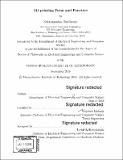| dc.contributor.advisor | Wojciech Matusik. | en_US |
| dc.contributor.author | Sundaram, Subramanian, Ph. D. Massachusetts Institute of Technology | en_US |
| dc.contributor.other | Massachusetts Institute of Technology. Department of Electrical Engineering and Computer Science. | en_US |
| dc.date.accessioned | 2019-02-14T15:49:37Z | |
| dc.date.available | 2019-02-14T15:49:37Z | |
| dc.date.copyright | 2018 | en_US |
| dc.date.issued | 2018 | en_US |
| dc.identifier.uri | http://hdl.handle.net/1721.1/120416 | |
| dc.description | Thesis: Ph. D., Massachusetts Institute of Technology, Department of Electrical Engineering and Computer Science, 2018. | en_US |
| dc.description | Cataloged from PDF version of thesis. | en_US |
| dc.description | Includes bibliographical references (pages 153-171). | en_US |
| dc.description.abstract | Integrating diverse functions inside man-made parts with specific shapes, in a highly scalable manner, is the central challenge in manufacturing. Functional integration is typically achieved by assembling specialized parts, each independently made using carefully designed production techniques - for example, in assembly lines in the automotive industry. Externally assembling specialized parts is tedious at certain length scales (e.g. mesoscale manufacturing), imposes restrictions on achievable geometries, and limits functional integration. In contrast, nature excels at packing disparate materials and functions into unconstrained geometries across different length scales (e.g. distributed sensors in cuttlefish, or sensorimotor pathways and resonant muscles in insects). These far exceed our current fabrication capabilities, and replicating all the functions of natural systems has remained a distant dream. 3D-printing has resolved many challenges in fabricating complex geometries, but despite its promise, assembling diverse materials (including solids, liquids and thin-films) and functions inside a single, printed composite is a current challenge. This thesis presents a set of materials, processes and design strategies - a full experimental toolkit - to address the question: how can we distribute diverse materials and functions in free-form geometries? First, a fully-3D-printed autonomous composite that can sense an external stimulus, process it, and respond by varying its optical transparency is described. The composite consists of seamlessly integrated solids (UV-cured polymers), thin-films (conducting and semiconducting, solvent-evaporated films), and encapsulated liquids. Techniques to engineer material interfaces are also presented in this section. A stimulus-free strategy to 3D-print self-folding composites at room temperature is presented in the second part of this thesis. Specifically, the focus is on printing flat electrical composites that fold into pre-programmed shapes after printing using residual stress defined in specific regions. This provides advantages in the fabrication speed, and also expands the range of achievable geometries when using solvent-based inks. The third portion of this thesis focuses on 3D-printing soft actuators. After highlighting a few example applications of printed actuator arrays, this is used as a case study for topology optimization based design strategies. It is shown that the inclusion of a topology optimizer in the 3D-printing pipeline enables the automated design and fabrication of high-dimensional designs. The final section of this work focuses on creating tactile sensor arrays, with an emphasis on the acquisition of tactile datasets that can be used to understand the human grasp. The concluding section summarizes the role of the fabrication strategies presented here in creating composites of increasing levels of autonomy and self-sufficiency. | en_US |
| dc.description.statementofresponsibility | by Subramanian Sundaram. | en_US |
| dc.format.extent | 171 pages | en_US |
| dc.language.iso | eng | en_US |
| dc.publisher | Massachusetts Institute of Technology | en_US |
| dc.rights | MIT theses are protected by copyright. They may be viewed, downloaded, or printed from this source but further reproduction or distribution in any format is prohibited without written permission. | en_US |
| dc.rights.uri | http://dspace.mit.edu/handle/1721.1/7582 | en_US |
| dc.subject | Electrical Engineering and Computer Science. | en_US |
| dc.title | 3D-printing form and function | en_US |
| dc.title.alternative | Three D-printing form and function | en_US |
| dc.title.alternative | Three dimensional printing form and function | en_US |
| dc.type | Thesis | en_US |
| dc.description.degree | Ph. D. | en_US |
| dc.contributor.department | Massachusetts Institute of Technology. Department of Electrical Engineering and Computer Science | |
| dc.identifier.oclc | 1084475803 | en_US |
